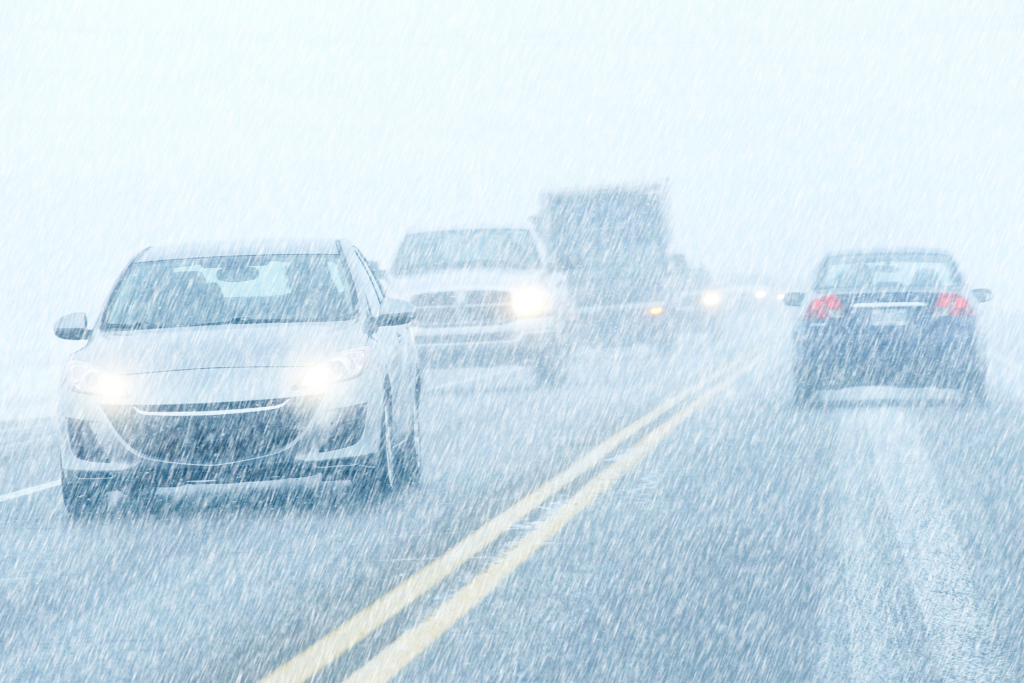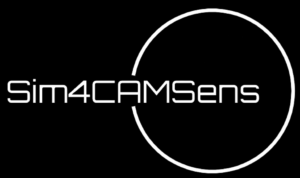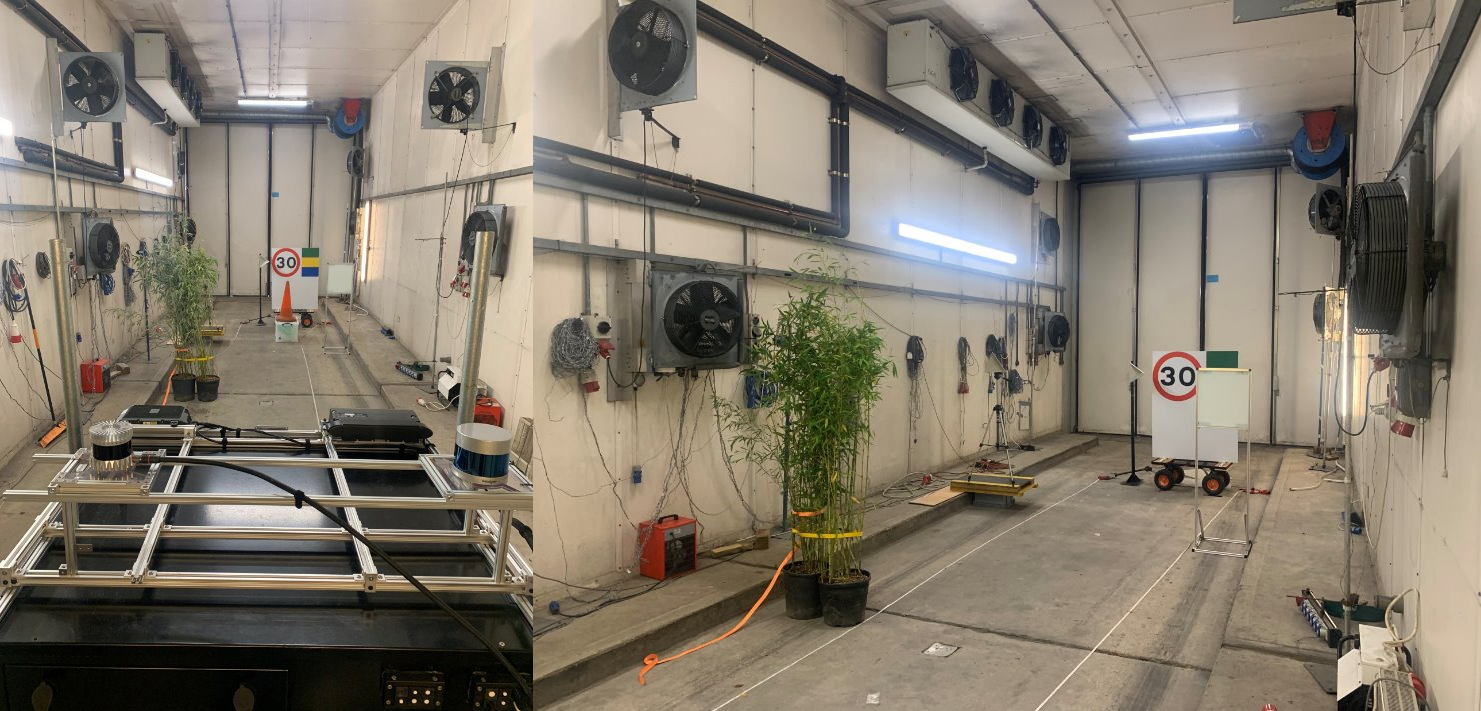Modelling, Simulation and Testing of automotive perception sensors
Sim4CAMSens is a CCAV funded project working on methods to quantify and simulate camera, radar and lidar sensor performance under all conditions.

Why are we testing perception sensors in winter conditions
Adverse weather conditions such as rain, snow, fog, and hail can greatly impair AV sensors’ performance. For example, raindrops and snowflakes can distort the signals of LiDAR sensors, whilst fog can reduce visibility for cameras, leading to incorrect object recognition. This sensor degradation in poor weather conditions poses a significant challenge to the safety and effectiveness of Autonomous Vehicles (AVs), necessitating urgent research and development.

Driving in snowstorm
As mentioned in our previous blog post, the Sim4CAMSens project, funded by the UK government, and led by Claytex, aims to revolutionise the field of autonomous vehicle technology by developing a robust supply chain for the modelling, simulation, testing, and characterisation of perception sensors used in automated driving functions. At the heart of Sim4CAMSens is the collaboration between a consortium of expert partners, each contributing unique expertise to address the challenges faced by the emerging UK-based perception sensors and systems industry. The project focuses on accelerating the development of perception sensors for assisted and automated driving functions, leveraging the UK’s outstanding modelling, simulation, and testing capabilities. This collaboration aims to create a globally competitive sensor design and development supply chain. Sim4CAMSens targets three key sensor technologies: RADAR, camera, and LiDAR. These sensors are essential for the safe and efficient operation of AVs, as they provide vital data about the vehicle’s surroundings. Autonomous vehicles rely entirely upon their perception sensors to determine their state and that of everything around them. The performance of these sensors is therefore a critical safety issue.
Through previous work with the Met Office, NPL have collected significant data on the performance of perception sensors at the Met Office’s Cardington test site under varying conditions. However, despite the length of the test campaign they have been running there is limited data on the effect of snow and winter conditions due to the test site’s location. As part of the Sim4CAMSens project, Claytex have defined a test campaign to address this gap by setting up a new test site in Scotland with the aim of capturing how a suite of perception sensors are affected by snow, frost and cold winter conditions. This knowledge is essential for building accurate sensor models and supports the design of sensors that can adapt to or compensate for these conditions, ensuring accurate and reliable data even in challenging weather.
The Sim4CAMSens Winter testing campaign, which is already underway in Scotland, is focused on capturing data that will enable the consortium partners to understand the relationship between weather and sensor performance. As with any real-world test work, one of the key concerns was to minimise the number of variables that could impact the experiments. The fewer the number of variables the easier it is to find relationships between the performance metrics and remaining variables. With the weather conditions being the variables of interest for this test campaign the easiest decision was to then make the sensors and targets static.
The noise factors caused by weather conditions are measured by comparing the received signal from the target under good weather conditions (reference signal), defined as no precipitation and visibility of over 2km, against the received signals under various weather conditions such as rain, snow and fog. These weather conditions are characterised using different rates and droplet size distributions so they can be classified as light snow, drizzle, or heavy rain, and combined with measures of visibility which can be classified as mist or fog. The reference signal is measured before and after the various weather events to minimise the influence of humidity and temperature on the measured noise factors. To quantify the weather effects, sophisticated weather sensors including a disdrometer and present weather sensor have been deployed. These will enable us to quantify the drop size spectrum, intensity of the drops, velocity of precipitation, and detect the different types of precipitation, such as wet snow, dry snow, frost, hail and mixed precipitation, along with assessing their impact on visibility.
The gained results from this winter test campaign will be used in a number of different ways by the project partners. The collected sensor data will be analysed using traditional performance metrics in combination with newly proposed automotive specific metrics, such as the LiDAR point cloud dissimilarity metrics, recently proposed by WMG, University of Warwick. The information will feed into the development of improved sensor models and the simulation environments used so that we can more accurately simulate the effect of weather and enable virtual testing of AVs under winter weather conditions. The data will also be used by Oxford RF Solutions to help steer the development of their radar based perception sensor and the aim is to help them deliver a more robust sensor to market sooner. Finally, the test process and learnings from the data analysis will help inform the work on test methods, guidance and standardisation that all the project partners want to see evolve from this project.
The decision by the project to focus on testing under winter weather conditions was in part informed through workshops on noise factors that have been run by WMG. These workshops have been held with the project partners as well as at major international conferences to ensure the needs of the wider community are understood.
Please get in touch if you have any questions or have got a topic in mind that you would like us to write about. You can submit your questions / topics via: Tech Blog Questions / Topic Suggestion
Project Updates
All the latest news, updates and information from our project partners.
CAV Catalogue – a comprehensive online listing for automated vehicles
The unique CAV Catalogue, has recently been updated, now offering a more comprehensive global directory of all L4 Automated Vehicles ...
Evaluating the impact of temperature and ice accumulation for lidar
Following on from last weeks post on Evaluating the impact of temperature and ice accumulation for radar, we will now ...
Evaluating the impact of temperature and ice accumulation for radar
During our first winter testing campaign (January to March 2024), we noticed some uncertainties in the results, which we suspected ...



